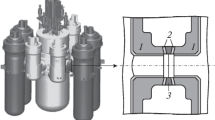Abstract
The influence of alloying elements, namely, silicon, manganese, nickel, and molybdenum, contained in the welding wire on the mechanical properties of the metal of automatic submerged-arc welding joints has been investigated. It has been established that the required strength and ductility values and the ductile-to-brittle transition temperature of the weld metal both in the as-welded state and upon high-temperature tempering are achieved by using welding wire with a silicon content of ~0.6% and a manganese content of ~1.5%.










Similar content being viewed by others
Notes
Refer to M.N. Timofeev, G.P. Karzov†, S.N. Galiatkin, E.I. Mikhaleva, S.G. Litvinov, A.G. Aleksandrin, D.L. Bashulin, and O.V. Shubin, Improvement of the Service Properties of the Weld Joint Metal for Transport Nuclear Power Units Manufactured of Heat-Resistant Steel Grades: Part I. Technology of Welding Heat-Resistant Steel Grades Using Low-Carbon Welding Materials without Heat Treatment and Experience of Applying Welding Materials, this issue.
Refer to M.N. Timofeev, S.N. Galiatkin, E.I. Mikhaleva, and O.V. Shubin, Improvement of the Service Properties of the Weld Joint Metal for Transport Nuclear Power Units Manufactured of Heat-Resistant Steel Grades: Part II. A Study of Mechanical Properties of Low-Carbon Weld Deposits Depending on the Welding Process Variables, this issue.
REFERENCES
Timofeev, M.N., Galiatkin, S.N., Shekin, S.I., and Mikhaleva, E.I., New agglomerated flux for automated welding of low alloyed thermoresistant steels, Svarka Diagn., 2017, no. 2, pp. 44–48.
Timofeev, M.N., Galiatkin, S.N., Mikhaleva, E.I., Komolov, V.M., and Korolev, S.Yu., New materials for automatic welding of equipment from 15Cr2MoV-A steel prospective AERs of WWER type ensuring the properties of welded metal at the level of requirements for the base metal, Materialy XIII mezhdunarodnoi konferentsii “Problemy materialovedeniya pri proektirovanii, izgotovlenii i ekspluatatsii oborudovaniya AES” (Proc. XIII Int. Conf. “Problems of Material Science during Engineering, Production, and Exploitation of Equipment for NPP”), St. Petersburg, 2014.
Konishchev, B.P., Kurlanov, S.A., Potapov, N.N., et al., Svarochnye materialy dlya dugovoi svarki. Spravo-chnoe posobie. Tom 1. Zashchitnye gazy i svarochnye flyusy (Welding Materials for Arc Welding: Handbook, Vol. 1: Protective Gases and Welding Fluxes), Potapov, N.N., Ed., Moscow: Mashinostroenie, 1989.
Timofeev, M.N., Galiatkin, S.N., and Mikhaleva, E.I., Properties of metal in a weld obtained using agglomerated flux in the welding of cases for water-cooled nuclear reactors, Vopr. Materialoved., 2014, no. 4 (80), pp. 148–155.
PNAEG-7-009–89. Oborudovanie i truboprovody atmonykh energeticheskikh ustanovok. Svarka i naplavka. Osnovnye polozheniya. Svarnye soedineniya i naplavki. Pravila kontrolya (PNAEG-7-009–89. Equipment and Pipelines of Nuclear Power Plants. Welding and Deposition. General Statements. Welded Joints and Depositions. Control Rules), Moscow: Energoatomizdat, 1991.
PNAEG-7-002–86. Normy rascheta na prochnost’ oborudovaniya i truboprovodov atmonykh energeticheskikh ustanovok (PNAEG-7-002–86. Standard Calculations for Reliability of Equipment and Pipelines of Nuclear Power Plants), Moscow: Energoatomizdat, 1989.
Kasatkin, O.G. and Mikhodui, L.I., Choice of alloying system for welding of highly refractory steels, Avtom. Svarka, 1992, no. 5, pp. 19–25.
Schastlivtsev, V.M., Kaletina, Yu.V., and Fokina, E.A., Ostatochnyi austenit v legirovannykh stalyakh (Residual Austenite in Alloyed Steels), Yekaterinburg: Nauch. Izd. Sov., Ural. Otd., Ross. Akad. Nauk, 2013.
Evans, G.M., The effect of silicon on the microstructure and properties of C–Mn all-weld metal deposits, Metal Constr., 1986, vol. 18, no. 7, pp. 438–444.
Solntsev, Yu.P., Andreev, A.K., and Grechin, R.I., Liteinye khladostoikie stali (Casted Cold-Resistant Steels), Moscow: Metallurgiya, 1991.
Rybakov, A.A., Filipchuk, T.N., and Kostin, V.A., Microstructure and hit viscosity of metal in welded joints of pipes from high-resistant steel with niobium and molybdenum, Avtom. Svarka, 2015, nos. 3–4, pp. 17–24.
Author information
Authors and Affiliations
Corresponding author
Additional information
Translated by O. Lotova
Rights and permissions
About this article
Cite this article
Timofeev, M.N., Galiatkin, S.N. & Mikhaleva, E.I. Improvement of the Service Properties of the Weld Joint Metal for Transport Nuclear Power Units Manufactured of Heat-Resistant Steel Grades: Part III. A Study of the Influence of Alloying Elements on the Characteristics of the All-Weld Metal as Applied to the Fabrication of Low-Carbon Metal Deposits and Assembly Weld Joints in Icebreaker Nuclear Power Units. Inorg. Mater. Appl. Res. 9, 1155–1164 (2018). https://doi.org/10.1134/S2075113318060266
Received:
Published:
Issue Date:
DOI: https://doi.org/10.1134/S2075113318060266




